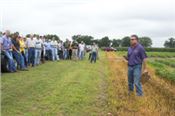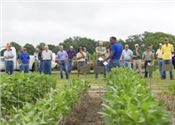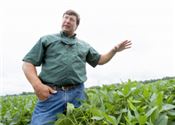|
New Tools To Fight Weeds Highlight LSU AgCenter Field Day
ST. JOSEPH, LA.
Anticipated heavy rainfall associated with the threat of Tropical Storm Cindy added to the struggle to stay one step ahead of Mother Nature, a recurring theme from presentations at the LSU AgCenter’s Northeast Research Station Pest Management and Crop Production Field Day.
“It seems like we’ve been fighting the weather all spring,” said Donnie Miller, AgCenter weed scientist and station coordinator.
Miller highlighted a new herbicide trait he anticipates will be available in 2018 saying producers should have another weed management tool with Balance GT soybeans – allowing application of Balance Bean, a soil applied herbicide, and glyphosate.
“The main way to fight weed resistance is to alternate modes of action, and this new technology will allow introduction of a unique one to soybeans, while also providing residual soil activity,” Miller said.
Development of a 3-way trait for tolerance to herbicides is in the works and anticipated for 2019 release, he said.
AgCenter plant pathologist Trey Price provided recommendations for disease concerns cropping up in corn, soybeans and cotton.
“There is no one-size fits all threshold. Application decisions should be based on crop stage, disease severity, prevailing environmental conditions and fungicide efficacy,” he said.
Charles Overstreet, AgCenter nematode specialist, said a dry spell in this year’s growing season will set the stage for heavy nematode damage to plant roots that are stunted because of moist conditions.
He said an ongoing study is focusing on the use of varying amounts of the nematicide Telone in different soil textures. The nematicide is not needed in heavier soils where nematodes cause less damage, he said
“We like resistance, but we can get higher yields with varieties that are susceptible,” Overstreet said.
Dennis Burns, AgCenter county agent in Tensas Parish, and R.L. Frazier, AgCenter county agent in Madison Parish, talked about their row rice demonstration project at the station. The plots were planted April 17.
Frazier said he prefers the term “furrow-irrigated rice,” and said farmers are using the system because it allows last-minute flexibility for choosing a crop to grow.
Burns said the plots have only been watered once because frequent rains have provided adequate moisture this year.
AgCenter agronomist and weed scientist Josh Copes highlighted a new precision planter equipped with Precision Planting’s Delta Force, hydraulic cylinders allowing for even seed depth placement, and two hopper units supporting planting of two varieties in a field.
Many Louisiana fields are not uniform with soil types gradually changing throughout the field. This planter allows for farming management zones within non-uniform fields by selecting two varieties or hybrids for specific management zones in fields.
“We want to do some on farm large plot research looking at changing hybrids/varieties and populations and analyze how changing these factors will affect yield and economic return for producers” Copes said.
Research projects in cover crop use are being stepped up to answer producer demand, AgCenter conservation agronomist James Hendrix said. “Cover crops will be just like a cash crop. You can’t just plant them in the fall and terminate them anytime in the spring thinking you have gained the most benefit because it doesn’t work that way,” Hendrix said.
“Our objective is to evaluate different cover crops for maximum benefits to soil health and to look at conventional till versus no-till systems for evaluating main crop yield,” AgCenter agronomist Syam Dodla said.
AgCenter entomologist Sebe Brown said cotton will be susceptible to thrips this year because of the cool spring and excess amounts of rain. He also anticipates aphids will move into cotton fields, but a fungus usually takes care of the insect. “It’s a better control than anything we can use,” he said.
Plant bugs are infesting cotton, he said, but approval has been granted for the pesticide Transform.
Brown said corn earworms will move into cotton and soybeans after corn has matured. “Just because you have Bt, doesn’t mean you are going to be protected.”
AgCenter cotton and corn specialist Dan Fromme said corn crops look phenomenal with a potential for 200-plus bushels per acre, reminiscent of 2013 yields.
Early planting in February and March, combined with rains showing up a bit later made a significant impact, allowing corn to get some size, he said.
Reductions in overall corn acreage and continued strong support may give corn prices a small boost, AgCenter economist Kurt Guidry said.
Cotton prices are starting to see some pressure due to more than a 50 percent increase in expected ending stocks, Guidry said.
With a record high of just under 90 million acres of soybeans planted in the U.S., the potential for an extremely large soybean crop combined with a large worldwide supply may bring prices down despite solid demand on both the domestic and export fronts, he said.
Rogers Leonard, LSU AgCenter associate vice president for plants, soils and water resources, said the Northeast Research Station is an essential part of the AgCenter’s research function.
“This station will remain open to address the farmers field crop needs in the Northeast Delta Region.”
He said some of the station’s land that is not being used for research will be leased to area farmers. “We leased some property two years ago and that arrangement has worked well,” Leonard said.
Another parcel of station land not protected by the Mississippi River levee could be purchased by the Tensas Parish Port Commission with the proceeds dedicated to support infrastructure for agricultural research in northeast Louisiana. The Louisiana State Legislature approved the sale during the last session with strong support from the region’s legislators.
Leonard said a new soybean specialist, Todd Spivey of North Carolina State, has been hired to replace Ron Levy. This position will be based at the Dean Lee Research Station. ∆

Donnie Miller, LSU AgCenter weed scientist, right, speaks to attendees of a field day
at the Northeast Research Station in St. Joseph, Louisiana.
Photos by Olivia McClure/LSU AgCenter

LSU AgCenter agronomist Syam Dodla, center right, tells attendees at the
Northeast Research Station field day about a test plot of cover crops.

LSU AgCenter field crop production specialist Josh Copes talks about one of
his soybean test plots at the Northeast Research Station field day.
|
|